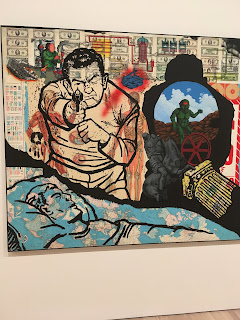Salvatore Rosa is from Arenella, Province of Naples, Italy. He was an Italian painter from the Baroque period. In the 17th century Rosa was known to be very versatile and a bandit or a rebel. One of his most known influences within his work is the romantic style within his paintings, including his use for themes with magic or wilderness. He painted for his own satisfaction and chose his own subjects on what to paint. The way he paints his face within his self-portrait has a sort of softness and emotion to it. His "Self-Portrait" painting was made in 1647 during the Baroque period, and it is an oil on canvas painting. It is 39 by 31 1/4 inches. His painting is dark, mysterious, almost sinister, and dramatic. Here he is carving into the skull the words "Behold, whither, when" in Greek. Behind him looks to be a dark clouded sky with a quarter moon quietly appearing in the corner. In his facial features he appears to be looking downcast as if he is depressed or mourning after writing the Greek words on the skull. Rosa's "Self Portrait" is a great example of art in the Baroque period because his painting shows qualities of emotion, drama, and dark symbols.
Agnolo di Cosimo was born in Florence, Italy 1503 and he practiced Renaissance style art. He later on changed his name to Bronzido. Bronzido's painting "Portrait of a Young Man" was created in the 1530s from the Renaissance period. It's an oil on wood painting that is 37 5/8 by 29 1/2 inches. The identity of the boy in the painting is unknown but Bronzido depicts him as innocent and thoughtful. As he stands with his book open and elegant clothing, he portrays a great example of a painting with the Renaissance period. The boys face is hard and stiff with a slight blush presented on his cheeks.





